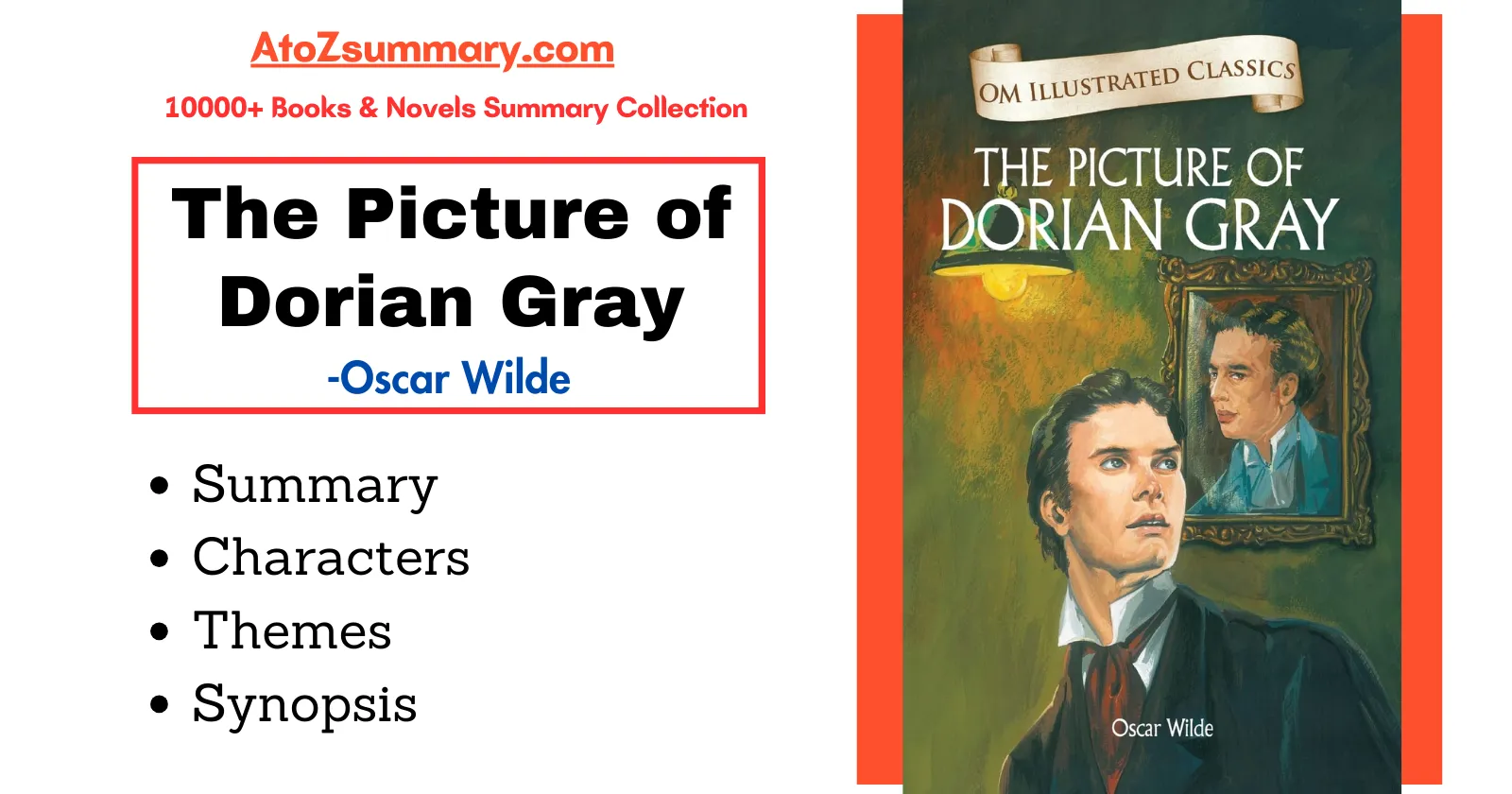
About the Novel- The Picture of Dorian Gray
| Title | The Picture of Dorian Gray |
| Author | Oscar Wilde |
| No. of pages | 304 pages |
| Language | English |
| Publisher | Fingerprint! |
| Publication Year | 1890 |
| Genre | Gothic novel, philosophical fiction |
| Setting | London, late 19th century |
Characters
The main characters of “The Picture of Dorian Gray” by Oscar Wilde are:
- Dorian Gray – The handsome and young main character who makes a wish that a portrait of himself ages instead of him. He lives a life of sin and corruption.
- Lord Henry Wotton – Dorian’s friend who introduces him to a hedonistic and amoral lifestyle, influencing Dorian’s actions.
- Basil Hallward – A talented artist who paints Dorian’s portrait and becomes obsessed with his beauty.
- Sibyl Vane – A young actress who falls in love with Dorian. Her tragic fate is tied to Dorian’s actions.
Themes
The themes of “The Picture of Dorian Gray” by Oscar Wilde are:
- The Corruption of Morality – The book explores how a life of indulgence and immorality can corrupt a person’s soul and lead to their downfall.
- The Nature of Beauty – It delves into the idea that beauty is fleeting and superficial, and how society often values it above all else.
- The Power of Influence – The story shows how the people we surround ourselves with can greatly influence our behavior and choices, for better or worse.
- Art and Aestheticism – It discusses the role of art in society and the idea that art should exist for its own sake, separate from moral or societal considerations.
- Concealment and Deception – Dorian’s secret life and the hidden portrait symbolize the theme of hiding one’s true self and the consequences of deceit.
- The Consequences of Actions – It illustrates how our actions, even hidden ones, eventually catch up with us and have consequences.
- The Search for Eternal Youth – The desire for eternal youth and the fear of aging are prominent themes in the novel.
- Social Hypocrisy – The story highlights the double standards and hypocrisy prevalent in society, where appearances often mask the truth.
Synopsis
The Picture of Dorian Gray is about a young man named Dorian Gray who gets a beautiful portrait of himself painted.
He wishes that he could stay young and handsome forever while the portrait ages instead. Dorian then lives a life of pleasure and sin, and his portrait reflects the damage to his soul, while he stays young.
The story shows how his actions lead to his own downfall. It’s a novel that explores the idea that a life without morals and responsibility can have serious consequences.
Watch Full Novel Summary & Analysis
Summary
The well-known artist Basil Hallward meets Dorian Gray at the opulent London mansion of his aunt, Lady Brandon. Basil’s artistic mind is quickly captured by Dorian, a well-educated, affluent, and breathtakingly handsome young man. Dorian poses for multiple photographs, and Basil frequently portrays him as a legendary or ancient Greek hero. The first portrait of Dorian as he is that the artist is doing as the book begins, but as he acknowledges to his friend Lord Henry Wotton, the painting disappoints him since it shows too much of his emotion for his subject.
Lord Henry disagrees and asserts that the portrait is Basil’s finest work. The famed wit likes shocking his friends by praising youth, attractiveness, and the hedonistic pursuit of pleasure. When Dorian arrives at the studio, Basil presents him reluctantly to Lord Henry out of concern for the impressionable young Dorian.
Basil’s worries come true as Lord Henry disturbs Dorian with a speech about the fleeting nature of youth and beauty before their first chat is through. Dorian curses his painting because he fears it will one day serve as a reminder of the beauty he will have lost. Dorian is concerned that these, his most striking qualities, are vanishing day by day. In a moment of despair, he offers his soul in exchange for the painting’s ability to carry the weight of fame and age while preserving his eternal youth. Following Dorian’s outbursts, Lord Henry reiterates his wish to purchase the image, but Basil maintains that Dorian is the rightful owner.
Lord Henry gains more sway over Dorian during the next weeks. The young person adopts the “new Hedonism” and suggests leading a life devoted to seeking pleasure. He develops feelings for Sibyl Vane, a young actress who works at a slum theater in London. He enjoys her acting; she calls him “Prince Charming” and ignores her brother James Vane’s advice that Dorian is not a good match for her. Sibyl is overcome by her feelings for Dorian and thinks she can no longer play the part, pondering how she can pretend to love on stage now that she has experienced it.
Dorian brutally calls off his engagement to Sibyl despite his love for her acting prowess. After that, he notices that his face in Basil’s image of him has altered, and now sneers when he gets home. He decides to make apologies to Sibyl the next day out of fear that his wish for his image in the painting to suffer the consequences of his actions has come true and that his misdeeds would be shown on the canvas. However, Lord Henry sends word that Sibyl committed suicide the same day. She represented tragedy, and at Lord Henry’s prodding, Dorian decided to look at her passing as a type of creative accomplishment and go on. Dorian, meanwhile, conceals his image in a private upstairs chamber of his home so that only he can see it change.
Dorian receives a book from Lord Henry that details the evil deeds of a Frenchman in the nineteenth century. As Dorian descends more and further into a life of depravity and corruption, this book becomes his bible. He has no concern for morals or the repercussions of his acts, living a life committed to experiencing new feelings and experiences. They are 18 years old.
In respectable London social circles, where reports of his scandalous antics circulate, Dorian’s reputation falls. Despite this, his classmates still accept him since he is still youthful and attractive. However, the painting’s figure ages and becomes more repulsive. Basil Hallward visits Dorian’s house on a gloomy, foggy night to confront him about the unfounded reports. Dorian finally grants Basil a glimpse into his (Dorian’s) soul after the two dispute. Hallward begs him to change after seeing Basil’s now-horrific portrait. Dorian murders Basil in a fit of wrath after claiming that it is too late for atonement.
Dorian uses the assistance of an ex-friend and doctor whom he has blackmailed to dispose of the body. The following evening, Dorian travels to an opium den where he meets James Vane, who is out to get revenge for Sibyl’s murder. Dorian flees to his estate in the countryside. He is entertaining visitors when he sees James Vane looking in via a window, which causes him to feel terrified and guilty. Dorian regains his sense of security after Vane is inadvertently shot and killed by a hunting party. The picture now exposes his purported intention to repent for what it is—hypocrisy—because he decides to change his life but lacks the guts to acknowledge his faults.
Dorian picks up the knife he used to stab Basil Hallward in a fit of rage and tries to slash the artwork. When there is a smash, his servants rush in to discover the uninjured painting of Dorian Gray as a handsome young man. The body of their master, an elderly man who had a knife inserted into his heart and was severely scarred and wrinkled, is lying on the ground.
FAQs
What are the lessons of The Picture of Dorian Gray?
It teaches us that living a life solely focused on external beauty and pleasure can lead to moral decay and the consequences of one’s actions catching up with them.
Why did Dorian want to destroy the picture?
Dorian wanted to destroy the picture because it depicted his moral corruption and aging while he remained youthful, reminding him of the consequences of his sinful lifestyle.
Is The Picture of Dorian Gray hard to read?
The Picture of Dorian Gray can be challenging due to its 19th-century language and complex themes, but it’s worth the effort.
Why is the person of Dorian Gray important?
Dorian Gray is important because he represents the consequences of a life consumed by vanity, hedonism, and moral corruption, as explored in Oscar Wilde’s novel. His character serves as a cautionary tale about the price of immorality and the fleeting nature of external beauty.
What are the lessons of The Picture of Dorian Gray?
“The Picture of Dorian Gray” teaches us that the pursuit of eternal youth and beauty, at the expense of morality and integrity, leads to a corrupt and empty life. It emphasizes the consequences of one’s actions and the importance of inner character over external appearances.
About the Author-Oscar Wilde

| Name | Oscar Wilde |
|---|---|
| Full Name | Oscar Fingal O’Flahertie Wills Wilde |
| Date of Birth | October 16, 1854 |
| Date of Death | November 30, 1900 |
| Nationality | Irish |
| Literary Period | Victorian and Aestheticism |
| Notable Works | -The Picture of Dorian Gray – The Importance of Being Earnest – The Ballad of Reading Gaol |










![The Catcher In The Rye Summary, Themes & Characters [by J. D. Salinger] The Catcher In The Rye Summary, Themes & Characters [by J. D. Salinger]](https://atozsummary.com/wp-content/uploads/2023/06/The-Catcher-In-The-Rye-Summary-Themes-Characters-by-J.-D.-Salinger.webp)
